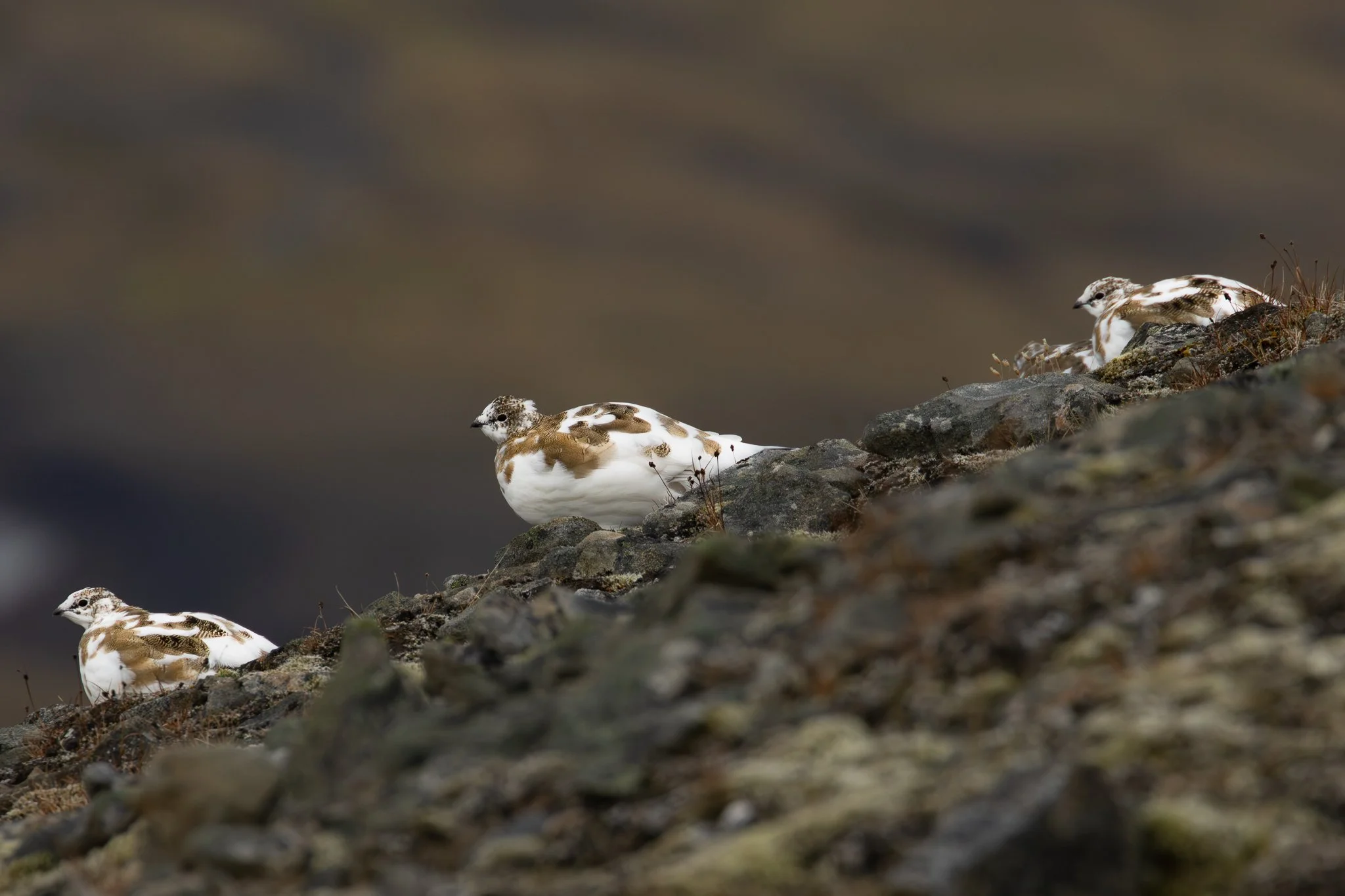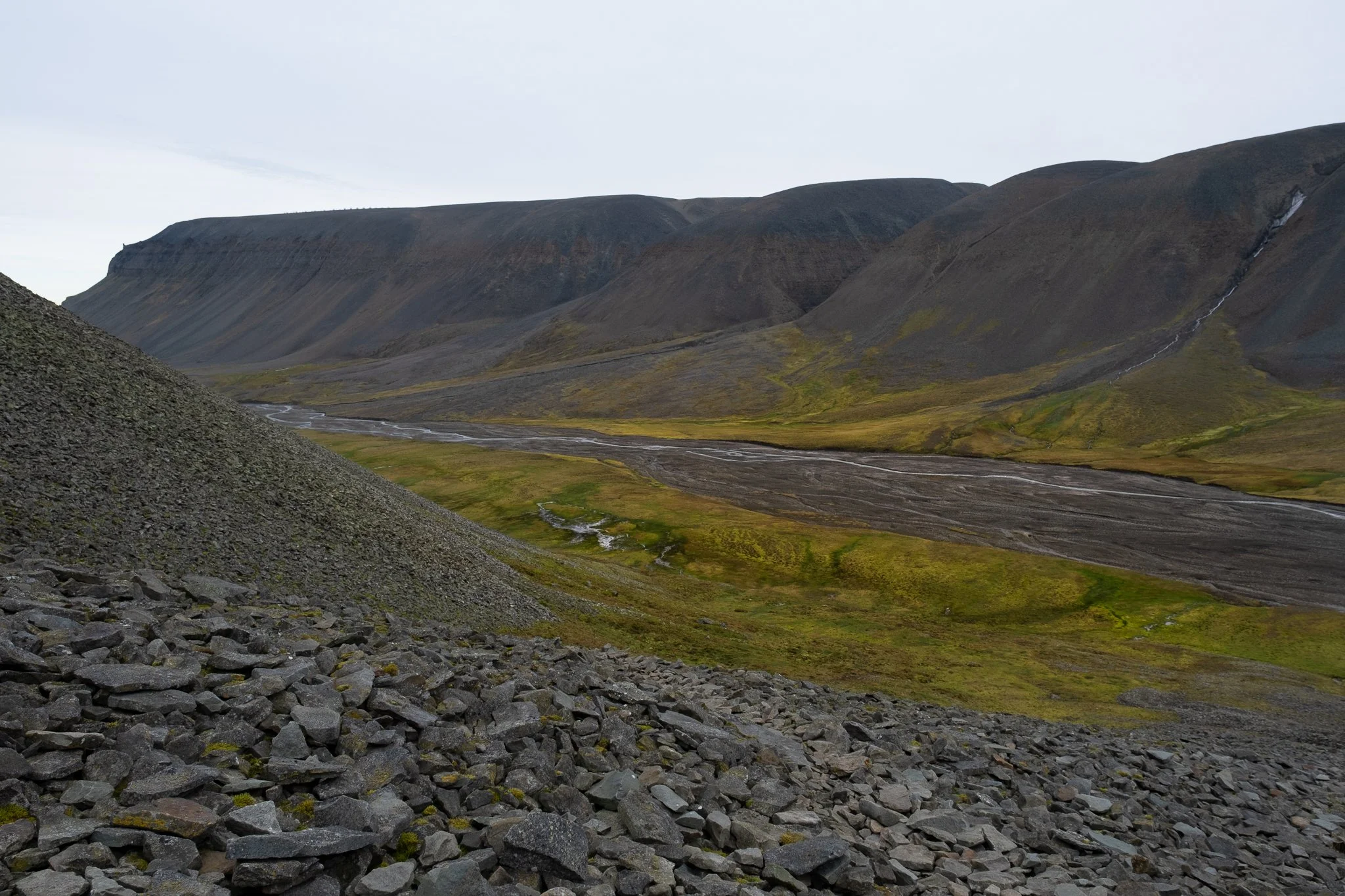Svalbard. The valley
Bjørndalen means ‘Bear Valley’ and it’s the first place I’ve seen in Svalbard outside of Longyearbyen. Two years ago, on my very first day on the islands, I went to Bjørndalen on a photo walk. I walked down a stretch of the valley with a photographer and our guide. We heard thousands of little auks calling through the valley and saw an Arctic fox. At the time the valley looked like a borderless expanse of snow flooded by the April sun.
That’s how I remembered it till I went back on an autumn hike in September last year. The hike took me down through the valley and, up the mountainside trail, all the way to the Fuglefjella cliffs. It was an overcast day, but the valley shone its light made of mosses, flowers and lichens, the trails and the cliffs alive with reindeer and birds.
I wonder what I’ll find next time I’m there.
I’m scrambling up a steep narrow trail by the riverbed. Except, the trail is not quite a trail and the river is no river at all. I keep a steady pace behind our guide Amalie, but I have to measure each step with caution. Three people are hiking behind me, I cannot lose my balance. Every now and then I manage a furtive sidelong glance, and when I do, my heart leaps: Bjørndalen exudes a sunless glow and I can smell the tundra from up here. It smells like damp grass, hard-edged stones, sodden moss. It smells yellow, green, red, brown, and steel blue.
Bjørndalen means ‘Bear Valley’ in Norwegian. There had to be a Bear Valley here. There’s a profound connection between polar bears and Svalbard, one that runs deep in the history and geography of this land. And valleys, valleys define the shape and fabric of these islands. It’s all peaks and valleys here, endless highs and lows.
If I squint I can almost see the spot where this morning we parked our van. The other side of Bjørndalen looks so far from here. So much has happened already that I’m not sure I remember it all. From the van we walked downhill. Green moss covered large swathes of the valley bottom. Soft, velvety to the touch, it came with the odd drooping saxifrage, Arctic willow and cottongrass. No tyres are allowed on the tundra, but walking is permitted. My boots sank into the moss like into a drenched mattress. At first I trod with caution, but soon I gave in to my own weight.
We headed toward the river flowing in the middle of the valley, Bjørndalselva. We changed into the water boots borrowed from the tour planner warehouse and crossed a web of rivulets and creeks. We changed back into our hiking boots and resumed the walk. A gaggle of Barnacle geese took off in the distance with a sudden rustle of wings.
Amalie led us up on high ground and announced that we’d be hiking up the mountainside trail. She pointed to ‘the trail by the riverbed’, as she called it. Another river? I saw a crack, a wrinkle, a scar – not a trail. A thin trickle of water flowing next to it – hardly a river. Up we went.
Loose stones paved the trail and rose up on both sides like barricades. Larger rocks up the mountainside were coloured in the bright orange of lichens. When I stepped on them, the stones under my feet let out a faint sound that echoed the gurgling of the river. A liquid whisper. A purple sandpiper hopped from rock to rock further up from us on the riverbed. Soundless, camouflaged: an invisible presence, but once I spotted it, I couldn’t look away.
We’ve now reached the top and I’m enchanted by this route. When I step onto the plateau, I greet it like an old friend. More moss. It carpets the whole mountaintop and it comes in hues I cannot name. It shades from dark fern green to olive to dark brown, then olive again and a dark yellow no one has seen before.
We walk the width of the plain all the way to the cliffs. A few Svalbard reindeer lie on the tundra. They gaze at us for a moment, but soon look away. We keep to our route so as not to scare them off.
We reach the edge of the mountain. The side of the massif we’re on is called Pilarberget. On my right the plateau stretches into a pointed edge at the mouth of the valley. The spot is marked by a low cairn, the usual hike guestbook strapped around it in a waterproof case. On my left Pilarberget forms a U-shape with the adjacent portion of the mountain, Fuglefjella. In the breeding season seabirds nest in their thousands on these cliffs. It’s late in the bird season now, though, and the area appears deserted.
Isfjorden sits quiet and mighty in front of me. ‘Ice Fjord’. A huddle of mountains and glaciers line the opposite side. In 1596, in what ended up being his last expedition, Dutch explorer Willem Barents reached the northwestern part of Spitsbergen, the largest of Svalbard islands. He thought he’d come to Greenland. He’d sailed through a sea of fog and ice and, when the sun revealed land, he took in the scenery and called it ‘Spitsbergen’, ‘Pointed Peaks’. We’re much further south here, but his peaks must have looked like these.
After a quick lunch break and a hot drink, we leave our gear behind and we walk toward the cairn. I fall behind as I take a moment to place my zoom lens back into my backpack. I’ve been carrying it all day and I’ve barely used it at all. When I reach the edge over the valley, Amalie looks me straight in the eye. ‘Ptarmigans’, she whispers. ‘Behind me.’ Goosebumps. I glance past her. One, two, three, four. Four ptarmigans are sitting in a neat row on the slope. ‘My lens’, I mumble. She looks at me: ‘Go. Now.’
I sprint into a run. My backpack looks out of reach and when I get to it I’m already out of breath. How did we walk this far? I grab the camera and the lens, toss the caps on the ground and attach the zoom. I sprint back. They’ll be gone by the time I get there. Why did I leave? Why did I think about photos instead of being there in the moment? I shouldn’t have rushed it, now they’ll be gone-
They’re still there. I lay on my stomach, so I’m at eye level with them. I see five heads from down here. They lack the distinctive red stripe above the eye: they must be females. Their plumage betrays the season change. Brown in summer, white in winter, a mottled pattern in between. Svalbard rock ptarmigans are the only resident birds on the archipelago. No migratory routes, no open-water winter flights for them. They belong here. Only their wings flap through the dark polar night.
I press the shutter a few times. The emotional impact of first-time wildlife sightings is enormous. I hope I never get used to it. I hope the joy of seeing a wild animal in its environment always feels as overwhelming as it does now. A few eternal minutes go by. Then a sudden bustle before they take off. I follow them with my eyes as they fly out, their stocky bodies no more than thin white specks over a valley that looks bottomless from here. There were seven, after all.



A special thank you to Svalbard Wildlife Expeditions and our guide Amalie for the amazing experience.
All opinions shared in this post are my own and my own only. I’m not getting paid for making promotional statements, I’m simply voicing my genuine thoughts.





